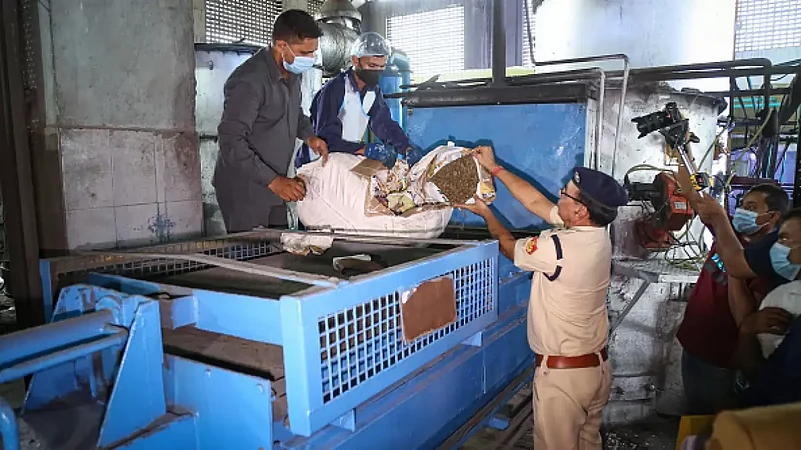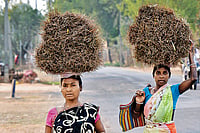It is 6 o’ clock in the evening and a middle-aged man wearing dhoti kurta is standing at the side of the road holding milk can at a neighbourhood in the heart of the city of Ranchi. Surrounded by half a dozen youth, this man takes out a plastic packet from the side pocket of his kurta and keeps the money received from these youths back in the pocket.
This plastic packet contains drugs that he sells four to five times a day. The noteworthy point is that the main road of the city is just 70 meters away from the lane and the traffic police can be found doing the routine checks at a mere distance of 100 meters.
One buyer, on the condition of anonymity, says, “I have been seeing this man since last two years. I think he has been selling it for many years. He comes five times during the day and bring different packets of drugs selling at the rates of 50, 100 and 500 rupees. There are many such places at Ranchi where drugs are being sold in this fashion. Kanta toil, Gudri chowk and many more places. I feel that marijuana worth Rs. 10,000 is being sold daily.”
Last month on August 15, at a routine checking conducted at Ranchi railway station two smugglers had been arrested with 28 kgs of marijuana. Four months prior to this, around 1000 kgs of marijuana were seized at Namkum that was being brought from Odisha.
If Jharkhand police is to be believed, most of the drugs (marijuana) that enters the state comes from Angul district of Odisha and enters Simdega and Jamshedpur, making its way to Bihar. Both of these districts share borders with Odisha. Police seizes around 150 to 200 kgs of drugs regularly. In the border area of Simdega, on an average 1000 to 1500 kgs of drugs get caught.
As per the data of the Jharkhand police, from January 2022 to March 2023, 5458.52 kgs of drugs have been recovered in the different districts of the state. According to the report of Magnitude of Use in India 2019, out of the total amount of marijuana used in the country, 0.3 percent of it gets consumed at Jharkhand.
However, police are of the opinion that more than the problem of drugs (marijuana), Jharkhand suffers a lot due to the cultivation of opium.
Why does maximum opium cultivation take place at Chatra and Khunti?
According to media reports, opium cultivation is done in many districts of Jharkhand. As per the information provided by the police, between 2011 and 2018, 6035.12 acres of opium cultivated has been destroyed by the police administration. Between January 2022 and March 2023, 1653.27 kgs of opium had been recovered in the state.
According to Police, opium cultivation is done more in those areas which have been affected by Naxalites. Chatra, Khunti, Latehar, Hazaribagh, Seraikela-Kharsawan, Palamu are some of the districts known for this, where Naxalites are very active.
Among these districts, both Chatra and Khunti districts of Jharkhand are famous for maximum production of opium. Police says that it is with the help of Naxalites, the villagers get engaged in opium cultivation.
Rakesh Ranjan, SP, Chatra, says, “In Chatra, action drive against opium smugglers has been intensified. In the last two seasons, around 3000 acres of opium cultivated have been destroyed. The administration is vigilant and continuously monitoring. With the help of drone survey, we keep an eye and if we come to know of any wrong deed, we get it destroyed with the help of JCB. The villagers are also being made to understand. As soon as the Naxalites get wiped out, opium cultivation will also get reduced, The best thing is that the villagers are becoming aware of the disadvantages of opium cultivation and are getting drawn towards cultivation of other crops.”
Other states are also linked with the opium cultivation in Jharkhand. Smugglers coming from outside, take a huge chunk of opium to Uttar Pradesh, Haryana, Maharashtra and Rajasthan. Ranjan says that the villagers who are engaged in opium cultivation are taught the art of cultivation by people coming from outside. Some years earlier, an opium smuggler from Punjab was arrested at Chatra. He had already spent ten years in prison for smuggling.
Aman Kumar, SP, Khunti, says, “Last year opium cultivation on 2300 acres in Khunti has been destroyed and this year on 1400 acres." He adds, “We have increased our reach in the Naxal affected area. The villagers also provide inputs. Its benefit can be seen in the increase in the amount of opium being destroyed every year. Dozens of villages are running campaigns against Gram Sabhas for carrying opium cultivation. With the help of district and police administration people have started farming of lemon grass, chickpea dragon fruit.”
Ajay Sharma, senior journalist who has been covering the opium smuggling related news for years, believes that the villagers are engaged in opium cultivation out of compulsion. He says that there is abject poverty at Khunti and there is no facility of irrigation. They do not get that much money from other crops as compared to opium cultivation. He says that the effort of the police administration is not enough and the administration does not have direct reach to the villages and there is lack of coordination with the Gram Sabha.
To stop the opium cultivation, the administration has to work in coordination with the Gram Sabha in the village.
Based on the data of these two districts, the scale at which opium cultivation is being done at Jharkhand can be clearly understood. According to a media report, opium cultivation is being done at 37 police station areas of 17 districts, out of 24 districts.
Youth are becoming the victims of drugs
Apart from marijuana and opium, the youth of Jharkhand have been caught in the trap of drugs, brown sugar, killer tablets, injection, dendrite, syrups. Between January 2022 and March 2023, 61.97 kgs of brown sugar, 12.51 gms of heroin, 28774 kgs of doda (poppy capsule), 10 gms of weed, 4593 syrup bottles of 100 gms, 184366 tablets and 4080 capsules have been seized.
Since last two years, Jharkhand State Jamiatul Quraish Organization has been running a campaign against drugs by covering every nook and corner of Ranchi. Its State President Mujeeb Qureshi says, “Since last five years, the number of drug addicts has increased at Ranchi. The boys in the age group of 18, 20 and 22 years can be found taking drugs in every nook and corner of the city. Many women have come to me to complain against those boys who take drugs and molest women. They are scared to go out. Since then, I have started my campaign against drug use. I believe that along with police administration other social and religious organizations have to come forward too. Otherwise, many houses and lives would be destroyed due to intoxication and drugs.”
The organization says that people are also dying due to intoxication. Mujib Quraishi gives an example of this, “I know of a person named Shamshad (name changed). He had two young sons of 20 and 18 years of age. Both of them remained intoxicated due to drugs. Both had become a burden for their father. A lot of efforts were made to get rid of drug addiction but nothing worked out. At last both of them died. Many such deaths have taken place at Ranchi. Drugs have been ruining peoples’ lives and their homes.”
In the last 15 months at Ranchi, between January 2022 and March 2023, 47 cases have been registered and 85 arrests have been made. 990 kgs of marijuana, 26 kgs of drugs, opium 17.90 kgs, poppy seeds’ capsules 1861, brown sugar 808 gms, weed 10 gms, tablet 20, syrup 138 bottles, 250 injections have been recovered.
As per Central Institute of Psychiatry (CIP) at Kanke, every month around 500 drug addicts arrive here. Dr. Basudeb Das, Director, CIP, says, “Most of the patients in our hospital are alcoholics. After that, we have patients taking brown sugar, opium, tablet, injection and dendrite. The age of these patients ranges from 20 to 35 years. We have 70 beds for such kinds of patients that always remain full. The remaining patients have to wait for the bed. The biggest challenge is to cure these patients as they reach the hospital in their last stage. When these patients do not get access to drugs, they start behaving abnormally. The family members bring them here.” Das adds that one can see the rise in the graph of both intoxication as well as patients in the city.
According to Jharkhand CID, as per the NDPC act, from January 2021 to April 2023, in 28 months, 1251 cases have been registered and 1943 smugglers have been arrested from the entire state. Aseem Vikrant Minj, IG, Jharkhand CID, says, “Here drug is synonym with opium cultivation and its supply chain, on which continuous action is being taken. Since its cultivation is more in Naxal affected areas, our reach and action have increased many folds here. Both police and district administration are working together to raise awareness among the villagers and in cities, youth in schools, and colleges against the ill effects of drug usage. I cannot say whether the graph has increased or decreased but the action has increased. Still lots need to be done.”
(Translated by Kaveri Mishra)



























